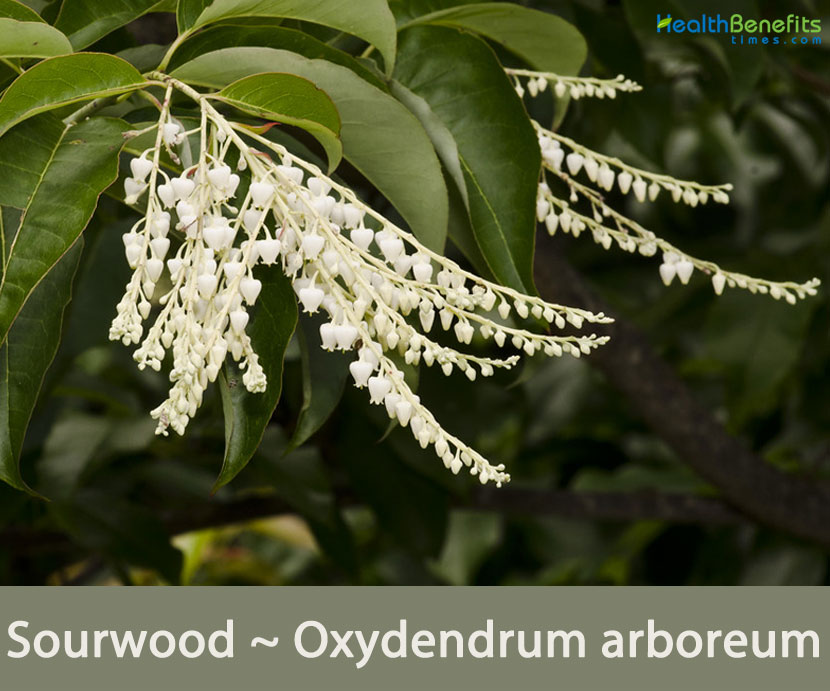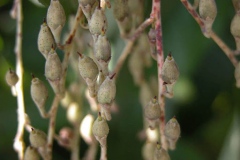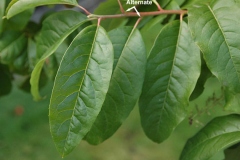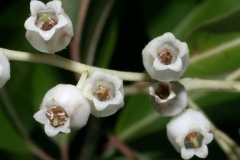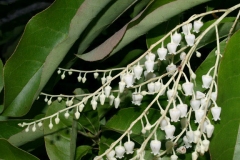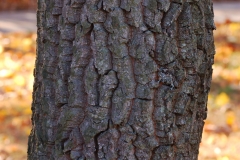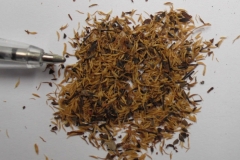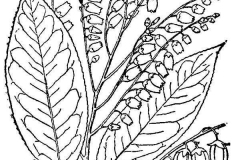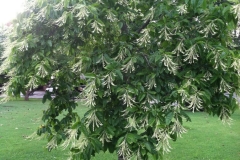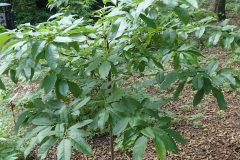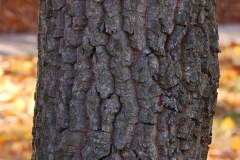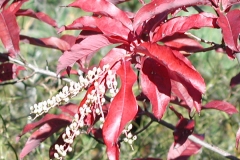| Sourwood Quick Facts | |
|---|---|
| Name: | Sourwood |
| Scientific Name: | Oxydendrum arboreum |
| Origin | Southwest Pennsylvania to southern Ohio, and southern Indiana, south to southeastern Louisiana and the coastal region of Mississippi, Alabama, and northwest Florida |
| Colors | Yellowish to greenish-grey colored |
| Shapes | Small, hard, dry, oval to egg-shaped, pointed capsules. |
| Taste | Pleasant acidic taste |
| Health benefits | Good for asthma, dysentery, diarrhea, kidney and bladder ailments, indigestion, menstrual bleeding, nausea, stomach ache, nervousness, and fever. |
| Name | Sourwood |
|---|---|
| Scientific Name | Oxydendrum arboreum |
| Native | Southwest Pennsylvania to southern Ohio, and southern Indiana, south to southeastern Louisiana and the coastal region of Mississippi, Alabama, and northwest Florida; west to western Kentucky and Tennessee, and to the Delta in Mississippi; and east to the Atlantic coast from southern Virginia to central North Carolina, and to the edge of the Coastal Plain in South Carolina and Georgia |
| Common Names | Sourwood, Lily-of-the-valley tree, Sorrel tree, common sourwood, titi, titi tree, arrowwood, elk tree, sorrel gum, sour gum, and tree Andromeda |
| Name in Other Languages | Afrikaans: Sourwood Albanian: Sourwood Amharic: Irit’ibi inich’eti (እርጥብ እንጨት), komit’at’ē (ኮምጣጤ) Arabic: Qashida (قشدة), sourwood Armenian: T’t’u p’ayt (թթու փայտ), sourwood Azerbaijani: Turşu, sourwood Basque: Sourwood Belarusian: Sourwood Bengali: Sourwood Bosnian: Sourwood Bulgarian: Sourwood Burmese: Saitpain (သစ်ပင်) Catalan: Sourwood Cebuano: Sourwood Chichewa: Sourwood Chinese: Suān mù (酸木), sourwood, Suānmó shù (酸模樹) Corsican: Legnu acidu Croatian: Sourwood, Kiselo drvo Czech: Kyselé dřevo, Surové dřevo, kysloun stromový Danish: Sourwood Dutch: Zuurhout, Sourwood English: Sourwood, Lily-of-the-valley tree, Sorrel tree, common sourwood, titi, titi tree, arrowwood, elk tree, sorrel gum, sour gum, and tree andromeda Esperanto: Acida lingo, sourwood Estonian: Hapupuu, Sourwood Filipino: Kulay-gatas, sourwood Finnish: Sourwood, Muikopuu French: Bois aigre, Raisin, andromède en arbre, arbre à l’oseille Frisian: Soerstof Galician: Sourwood Georgian: Arazhani (არაჟანი), sourwood German: Sauerholz, Sauerbaum, gemeiner Sauerbaum Greek: Xylo (ξυλο), Xyleía (Ξυλεία) Gujarati: Khāṭō lākaḍuṁ (ખાટો લાકડું), sourwood Haitian Creole: Sourwood Hausa: Garin katako, sourwood Hawaiian: Lāʻau ʻawa Hebrew: עץ חמוצה Hindi: Sourwood Hmong: Sourwood Hungarian: Sourwood Icelandic: Súrviður, Sourwood Igbo: Sourwood Indonesian: Sourwood, Kayu mas Irish: Sourwood Italian: Sourwood, albero ossalida, ossidendro arboreo Japanese: Sawāuddo (サワーウッド), Shiuuddo (シウウッド), Suibanoki (スイバノキ) Javanese: Kayu manis, sourwood Kannada: Huḷi mara (ಹುಳಿ ಮರ), sourwood Kazakh: Qışqıl ağaş (қышқыл ағаш), sourwood Khmer: Sourwood Kinyarwanda: Sourwood Korean: Sawo udeu (사워 우드), sin namu (신 나무) Kurdish: Dara gûzê, dara tirş Kyrgyz: каймак Lao: Mak u (ໝາກ ອຶ), sourwood Latin: Sourwood Latvian: Skābs koks, Sourwood Lithuanian: Rūgštynės, Sourwood Luxembourgish: Sauerholz Macedonian: Kiselo drvo (кисело дрво), sourwood Malagasy: Sourwood Malay: Sourwood Malayalam: Puḷipp ( പുളിപ്പ്), seā’urveā’od (സൊഉര്വൊഒദ്) Maltese: Injam ħelu, sourwood Maori: Sourwood Marathi: Āmbaṭavuḍa (आंबटवुड), sourwood Mongolian: Isgelen mod (исгэлэн мод), sourwood Myanmar (Burmese): Sourwood Nepali: Sā ucaravuḍa (साउचरवुड), sourwood Norwegian: Sourwood, Syretre Odia: ଖଟା Oriya: ଖଟା Pashto: لرګي Persian: Sourwood, اکسیدندرام Polish: Kwaśne drzewo, sourwood, Kwaśnodrzew amerykański Portuguese: Sourwood, Ovelha Punjabi: Khaṭā lakaṛa (ਖੱਟਾ ਲੱਕੜ) Romanian: Sourwood Russian: Sourwood, Oksidendrum (Оксидендрум) Samoan: Sourwood Scots Gaelic: Sourwood Serbian: Kiselo drvo (кисело дрво), sourvood (соурвоод) Sesotho: Sourwood Shona: Huni Sindhi: داڻا Sinhala: æm̆bul lī (ඇඹුල් ලී), sourwood Slovak: Sourwood Slovenian: Kislo drva, sourwood Somali: Sourwood Spanish: Madera agria, Significado de sourwood, Kislikavec Sudanese: Buah kayu pajar, sourwood Swahili: Sourwood Swedish: Sourwood Tajik: Cormagz (чормагз), sourwood Tamil: Puḷippu (புளிப்பு), sourwood Tatar: кычыткан Telugu: Sourwood Thai: Sourwood Turkish: Sourwood Turkmen: Turşu Ukrainian: Kyslytsi (кислиці), sourwood [sourwood] Urdu: ھٹی لکڑی, sourwood Uyghur: Sourwood Uzbek: Nordon daraxt, sourwood Vietnamese: Gỗ chua, sourwood Welsh: Sourwood Xhosa: Umthi omuncu Yiddish: sourvood (סאָורוואָאָד) Yoruba: Sourwood Zulu: I-sourwood, sourwood |
| Plant Growth Habit | Deciduous, small to medium-sized tree |
| Growing Climates | Woodlands on free-draining or gravelly acidic soils; on cliff faces, along streams and around the margins of swamps and pine heaths, dry rocky woods, in pine or mixed pine and hardwood stands, in hardwood forests, and well drained woodlands of bluffs |
| Soil | Moist, organically rich, well-drained soils; acidic, clay, loam, sand |
| Plant Size | 10–20 m (33–66 ft.) tall with a trunk up to 50 cm (20 in) diameter. Occasionally on extremely productive sites, this species can reach heights in excess of 30 meters and 60 cm diameter |
| Root | Sourwood roots are developed from a taproot sensing aerated soil depth and throwing out lateral roots behind its tip |
| Branchlets | Branchlets at first are light yellow green, but later turn reddish brown |
| Bark | Grayish brown, very thick with deep furrows and scaly ridges; often the ridges are broken into recognizable rectangles |
| Wood | Wood is reddish brown, with paler sapwood; it is heavy, hard, and close-grained, and will take a high polish. Its specific gravity is 0.7458, with a density of 46.48 lb/cu ft. |
| Leaf | Leaves are simple, thin, deciduous, and oblong-elliptical to oblong-lanceolate in shape. Leaf tip has a long point and the leaf base is wedge-shaped. Leaf margin can be a combination of several forms. Leaf tip has a long point and the leaf base is wedge-shaped. Leaf margin can be a combination of several forms |
| Flowering season | June to August |
| Flower | Individual sourwood flowers are small, regular, symmetrically shaped, fragrant, and showy. Individual flowers are bell or urn shaped with white to creamy-white colored petals. The flowers are waxy, slightly minutely hairy, and small about 0.25 to 0.33 inches long. |
| Fruit Shape & Size | Small, hard, dry, oval to egg-shaped, 5-celled, yellowish to greenish-grey colored, pointed capsules about 0.35 inches long containing 25–100 narrowly oblong seeds, ripening in autumn and persisting through winter |
| Fruit Color | Yellowish to greenish-grey colored |
| Propagation | By seeds or by softwood cuttings |
| Lifespan | Up to 200 years if planted at the right site |
| Taste | Pleasant acidic taste |
| Plant Parts Used | Leaves |
| Season | September through October |
Plant Description
Sourwood is a deciduous, small to medium-sized tree that normally grows about 10–20 m (33–66 ft.) tall with a trunk up to 50 cm (20 in) diameter with a straight, slender trunk and narrow oblong crown. Occasionally on extremely productive sites, this species can reach heights in excess of 30 meters and 60 cm diameter. The plant is found growing in woodlands on free-draining or gravelly acidic soils, on cliff faces, along streams and around the margins of swamps and pine heaths, dry rocky woods, in pine or mixed pine and hardwood stands, in hardwood forests, and well drained woodlands of bluffs. The plant prefers moist, organically rich, well-drained soils. It also does best in acidic, clay, loam sand.
Roots
Sourwood roots are developed from a taproot sensing aerated soil depth and throwing out lateral roots behind its tip. This juvenile taproot is soon compartmentalized away from the tree and a mature fibrous root system is sustained. Sourwood has a shallow, high oxygen demanding root system which is not effective with too much interference from other species. Sourwood does not have any significant allopathic impact of its own. Sourwood will sprout effectively from its stump and root crown area.
Bark
Sourwood periderm is unusual among other hardwood tree species. The periderm is shiny grey to reddish-grey-brown on the surface with a reddish-orange inner layer. Periderm is deeply creased with long furrows and short horizontal dividing fissures which yield a rectangular blocky texture (like persimmon). Mature periderm is usually 0.66 to 1.0 inch in thickness.
Twigs
Sourwood twigs are stiff but slender, with a crooked or zigzag growth pattern. First year twigs are reddish to bronze colored, while older twigs range from reddish-green to reddish-orange to yellowish-brown in color. Twigs are smooth with conspicuous orange or red tinted, oblong shaped, lenticels.
Leaf scars are shield or triangular shaped and raised above the twig surface, with no associated stipular scars. Each leaf scar has a single C or V shaped bundle scar. The pith is solid, white colored, round in cross-section, and has no cross walls. Sourwood is notorious as being extremely difficult to propagate from twig cuttings.
Buds
Sourwood has no true terminal buds. Lateral bud becomes the new shoot leader for each growth flush and each new season. Lateral bud dominance gives twigs a crooked or zig-zag appearance. Lateral buds are sparsely and minutely hairy on bud scale margins and across the inner surface. Lateral buds are small, round or globular shaped, 0.08 to 0.13 inches in diameter, and unstalked. They appear to be partially imbedded in the periderm. Buds have 3-6 dark red, rounded scales terminating in a minute point at the bud top.
Leaves
Sourwood leaves are arranged along the twig in an alternate or spiral form. Leaves are simple, thin, deciduous, and oblong-elliptical to oblong-lanceolate in shape. Leaf tip has a long point and the leaf base is wedge-shaped. Leaf margin can be a combination of several forms. The most common margin is finely toothed or finely toothed except near the base. The least common leaf margin is a smooth, untoothed edge. Leaves are sour or bitter to taste. Leaves are 4.5 – 7.5 inches long on average and 1.2 – 3.0 inches wide on average.
The upper leaf surface is shiny, smooth, with a bright yellowish green to a darker green color, if in full sun, and a yellowish-orange tinted green color under shaded conditions. The leaf underside has a bright yellow mid-rib which has stiff minute hairs (trichomes). These trichomes can occasionally also appear on the upper leaf surface over the midrib. The lower leaf surface is paler green than the upper leaf surface. Leaves are connected to the twig with a 0.66 to 1.0 inch long petiole covered with a few stiff small trichomes. Leaves begin senescence early and generate a bright crimson or purplish-burgundy color in early fall while most other trees are still fully green.
| Leaf arrangement | Alternate |
| Leaf type | Simple |
| Leaf margin | Serrulate, entire, undulate |
| Leaf shape | Oblong, lanceolate |
| Leaf venation | Pinnate, brachidodrome |
| Leaf type and persistence | Deciduous |
| Leaf blade length | 4 to 8 inches |
| Leaf color | Green |
| Fall color | Red, orange |
| Fall characteristic | Showy |
Flowers
Sourwood trees are co-sexual (both male and female parts within each flower) with very noticeable and unique flowering structures. Individual sourwood flowers are small, regular, symmetrically shaped, fragrant, and showy. Individual flowers are bell or urn shaped with white to creamy-white colored petals. The flowers are waxy, slightly minutely hairy, and small about 0.25 to 0.33 inches long. A number of people compare individual sourwood flowers with the bulb perennial herbaceous flower called “lily of the valley” in form. Petals form five short lobes. Petals are held at their base by sepals which all together form five lobes and stay attached as the fruits ripen. Each flower contains ten stamens.
Flowers are generated after the leaves have already expanded. Numerous small flowers are held on one side of long sweeping or drooping sprays, each spray (raceme) being 5.5 – 10 inches long. The end of upper branches can produce 3-8 terminal racemes of flowers around the entire crown. Lower branches may generate fewer racemes. Light colored, flower racemes and their sweeping, elongated growth form, provide a lacy or soft textured appearance to the tree. Flowers are insect pollinated, primarily by bees, using rich nectar and fragrant smell for attraction. Each flower produces small amounts of pollen. Flowering occurs near mid-growing season, roughly late May to mid-July across the range. Flowers dangle downward until about ten days after fertilization when the individual flower stems begin to curl upward. The individual flower stems have fine minute trichomes. Flowering normally takes place in between June to August.
| Flower color | White/cream/gray |
| Flower characteristics | Showy |
Fruit
Fertile flowers are followed by small, hard, dry, oval to egg-shaped, yellowish to greenish-grey colored, pointed capsules which can split along five lines on the sides. The capsule is covered with minute hairs and the fruit stands erect on a curved, short, fruit stalk which earlier in the growing season had dangled downward to enable flower fertilization. Capsule is about 0.35 inches long. The capsule ripens by the first of October and remains attached to the tree long after splitting in late fall to release many tiny seeds. Seeds are continually released into winter. Fruit collection should be in late fall. Do not collect any fruit which hangs down. Rub the fruits together to split the capsule and release the seeds.
| Fruit shape | Oval |
| Fruit length | Less than .5 inch |
| Fruit covering | Dry or hard |
| Fruit color | Brown |
| Fruit characteristics | Does not attract wildlife; not showy; fruit/leaves not a litter problem |
Seeds
Each capsule holds many minute, oblong shaped, pale brown to orange-yellow colored, wingless, 0.125 inch long seeds. Each seed is surrounded by a loose, thin, papery seed coat which looks like two small wings or points. Seeds freshly out of the capsule in late fall have no dormancy requirement and no pretreatment is needed for germination except for having at least four hours of light on the seedbed. Seed production occurs every year with large variability in seed numbers. Expect 2-5 million seeds per pound.
Traditional uses and benefits of Sourwood
- Leaves are cardiac, diuretic, refrigerant and tonic.
- Tea made from the leaves has been used in the treatment of asthma, diarrhea, and indigestion and to check excessive menstrual bleeding.
- It is diuretic and is a folk remedy for treating fevers, kidney and bladder ailments.
- Bark has been chewed in the treatment of mouth ulcers.
- Sourwood has been used for millennia for different human ailments.
- Native Americans used leaf infusions for treating menstrual and menopause problems, diarrhea, lung and breathing problems, and as a sedative for nerves.
- Sap, gum, or inner bark was applied for skin irritation and chewed for mouth sores.
- European Americans used sourwood as a tonic, decoction, pills made from solid tree tissues, and as a tincture.
- Sourwood products were used to treat urinary problems (increase urine flow / diuretic), enlarged prostate, bowel troubles, diarrhea, dysentery, stomach ache, and fever.
- Sourwood gum was chewed to alleviate thirst and treat mouth sores, and the green bark was rubbed on itchy skin.
- Sourwood whiskey tinctures used in tonics were targeted primarily at men’s urinary tract problems, leg swelling, and for heart problems.
- Leaves can be chewed (but should not be swallowed) to help alleviate a dry-feeling mouth.
- Sourwood tea can also cure fevers, nausea, and stop excessive menstrual bleeding.
- You can also chew the bark of this tree to treat mouth ulcers and canker sores.
- Herbal tea can be used to alleviate symptoms of asthma, dysentery, diarrhea, as well as kidney and bladder ailments.
- Sourwood infusions can be used to stop diarrhea.
- They also made it into a tonic for indigestion, nervousness, asthma and spitting blood.
Culinary Uses
- The youngest new leaves have been used to act as a sorrel green (sour / acidic taste) in salads.
- Young sourwood leaves can be a wonderful addition to salads and stews.
- You can also boil sourwood leaves to make a delicious herbal tea.
- Herbal tea has a zesty flavor that will taste amazing when paired with honey.
- Juice from these flowers is usually used to make sourwood jelly.
Other Facts
- Wood is occasionally used for paneling, tool handles, bearings etc.
- Sourwood is occasionally used as an ornamental because of the brilliant fall color of its leaves and midsummer flowers.
- Flowers of sourwood are also an important source of honey.
References:
https://www.itis.gov/servlet/SingleRpt/SingleRpt?search_topic=TSN&search_value=23690#null
https://npgsweb.ars-grin.gov/gringlobal/taxon/taxonomydetail?id=311632
https://pfaf.org/user/Plant.aspx?LatinName=Oxydendrum+arboreum
https://www.missouribotanicalgarden.org/PlantFinder/PlantFinderDetails.aspx?kempercode=a887
https://gd.eppo.int/taxon/OXDAR
https://www.fs.fed.us/database/feis/plants/tree/oxyarb/all.html
http://www.theplantlist.org/tpl1.1/record/tro-12300622
https://www.srs.fs.usda.gov/pubs/misc/ag_654/volume_2/oxydendrum/arboreum.htm
https://edis.ifas.ufl.edu/publication/ST429
https://www.cabi.org/isc/datasheet/38178
https://plants.usda.gov/home/plantProfile?symbol=OXAR


